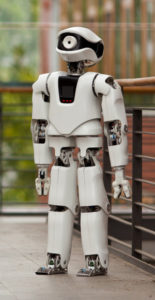Society is currently living through the “fourth industrial revolution”. This new digitally-based revolution is shaking up industries at unprecedented levels and it centers around one key theme:Robotics.
Robotics is the branch of technology that deals with the design, construction, operation, and application of robots, as well as computer systems for their control, sensory feedback, and information processing. These technologies deal with automated machines that can take the place of humans in dangerous environments or manufacturing processes, or resemble humans in appearance, behavior, and/or cognition
There is a wave of robotics emerging across all sectors.Today the field of robotics is one of the most dynamic areas of technological development. However, the lack of intelligence in current industrial and service robots severely limits their applications. Therefore, the most important issue in advancing this field further is endowing robots with cognitive abilities. In order to reach that level of sensory-motor coordination and cognition that will allow them to understand and effectively operate in household and industrial environments, interact with humans, and adapt their actions to an ever growing range of situations, scientists are bringing together the concepts of computational intelligence and neuroscience in robotics applications which play an important role in improving the robot’s capacities not only in increasing productivity in manufacturing but also in intelligence development so that robots can substitute human’s thinking and planning capacity.
Recently, neuroscience has been applied to robots to generate intelligence models with biological nervous systems. The intersection between robotics and neuroscience highlights many promising approaches and applications, for example, the neurorobots, brain-inspired algorithms and devices in robotics, and neural network-based navigation. This leads to one of the most significant paradigms shifts and improvements in the robotics field, giving rise to new field viz neurorobotics,a promising pathway towards intelligent robots.
Neurorobotics is an emerging science that studies the interaction of brain, body, and environment in closed perception–action loops where a robot’s actions affect its future sensory input. At the core of this field are robots controlled by simulated nervous systems that model the structure and function of biological brains at varying levels of detail. In a typical neurorobotics experiment, a neurorobot or agent will perceive its current environment through a set of sensors that will transmit their signals to a simulated brain. The brain model may then produce signals that will cause the neurorobot to move, thereby changing the agent’s perception of the environment. Neurorobots are robotic devices that have control systems based on principles of the nervous system. These models operate on the premise that the “brain is embodied and the body is embedded in the environment”. Therefore, neurorobots are grounded and situated in a real environment.
One of the first researchers to apply the concepts of neurorobotics was Thomas Ross, who in 1933 devised a robot with a small electromechanical memory cell that could learn its way through a very simple maze via “conditioned reflex”. In his 1948 book Cybernetics, Norbert Wiener laid the theoretical foundation for robotics as “the study of control and communication in the animal and the machine”. Since then, however, robotics research has focused largely on industrial applications.
Recently, industry has again been advancing technology by building robotic bodies that are softer, more flexible, and more durable than before. However, despite numerous attempts, no robot today matches the cognitive or behavioral abilities of even the simplest animals, let alone humans. What is still missing after decades of effort? Robots are still lacking a brain that allows them to learn to adapt to and exploit the physics of their bodies. Today, there are two main schools of thought in neurorobotics research. The first focuses on biologically inspired robots with bodies, sensors, and actuators that mimic structural and functional principles at work in the bodies and organs of living creatures. The second concentrates on brain-inspired control architectures.
Biologically inspired robots are adaptable and can display rich perceptual and behavioral capabilities. In contrast to industrial robots, they often use compliant materials that make their mechanics intrinsically flexible. Examples of advanced biology-inspired humanoid robots are the iCub, a humanoid robot “child” ; Kojiro, a humanoid robot with about 100 artificial muscles ; ECCEROBOT (Embodied Cognition in a Compliantly Engineered Robot), a humanoid upper torso that attempts to replicate the inner structures and mechanisms of the human body in a detailed manner; Roboy, a soft human body with a spine and a head that can display several emotional patterns ; the ASIMO robot ; Atlas, the latest agile anthropomorphic robot developed by Boston Dynamicsand, most recently, Sophia, a social humanoid robot developed by Hong Kong based company Hanson Robotics.
The ASIMO robot and Atlasare constructed from hard materials and implement research in machine walking. Such adv ances in multilegged robots have led to a renewed interest in applications for the military [BigDog, also from Boston Dynamics; disaster management [iRobot’s PackBot, a snake-like robot developed by Hitachi-GE Nuclear Energy and IRID (International Research Institute for Nuclear Decommissioning), and a scorpion-like robot from Toshiba; and entertainment [the NAO and Pepper robots from Aldebaran Robotics. Researchers have also developed robots that can mimic the characteristics of animals, such as locomotion in snakes and spiders, whisking in rodents, or jumping in frogs.
ances in multilegged robots have led to a renewed interest in applications for the military [BigDog, also from Boston Dynamics; disaster management [iRobot’s PackBot, a snake-like robot developed by Hitachi-GE Nuclear Energy and IRID (International Research Institute for Nuclear Decommissioning), and a scorpion-like robot from Toshiba; and entertainment [the NAO and Pepper robots from Aldebaran Robotics. Researchers have also developed robots that can mimic the characteristics of animals, such as locomotion in snakes and spiders, whisking in rodents, or jumping in frogs.
Brain-inspired control architectures are robotic control systems that on some level reflect properties of animal nervous systems. In general, they are tailor-made for a specific set of tasks, often using a combination of artificial neural networks, computer vision/audition, and machine learning algorithms. Early work in this field was done by Miyamoto et al., who developed an artificial neural network with brain-inspired hierarchical architecture that could control an industrial manipulator by acquiring a dynamical model of the robot through the “feedbackerror-learning” method. Later, Edelman et al. developed the “Darwin” series of recognition automata to study different behavioral phenomena ranging from pattern recognition to association to autonomous behavior and sensorimotor coordination.
Cox and Krichmar derived a robot controller based on the neuro-modulatory systems of mammalian brains. Burgess et al. used a mobile robotto test a model of the rat hippocampus. Ijspeert’s group investigated low-level mechanisms of locomotion in vertebrates by constructing a salamander robot controlled by central pattern generators. Further work has included self-organizing synchronization in robotic swarms and the learning of compositional structures from sensorimotor data. Lund et al. used spiking-neuron models to derive a model for cricket phono taxis that they evaluated on a mobile robot. Since then, spiking neural networks have become a standard tool in brain-based robotics and are used to control complex biomechanical systems such as the musculoskeletal model of the human body developed by Nakamura’s group. For example, Sreenivasa et al. published a study on modeling the human arm stretch reflex based on a spinal circuit built of spiking neurons. Kuniyoshi et al. developed a fetus model to simulate the self-organized emergence of body maps in a nervous system of spiking neurons. Finally, Richter et al. controlled a biomimetic robotic arm with a model of the cerebellum that was executed in biological real-time on the SpiNNaker neuromorphic computing platform.
A third line of research that is usually not mentioned along with neurorobotics—but with which it greatly overlaps—is neuroprosthetics, which can in fact be viewed as the translational branch of neurorobotics.
To advance neurorobotics further, a close collaboration between neuroscientists, roboticists, and experts in appropriate computing hardware is clearly mandatory.


